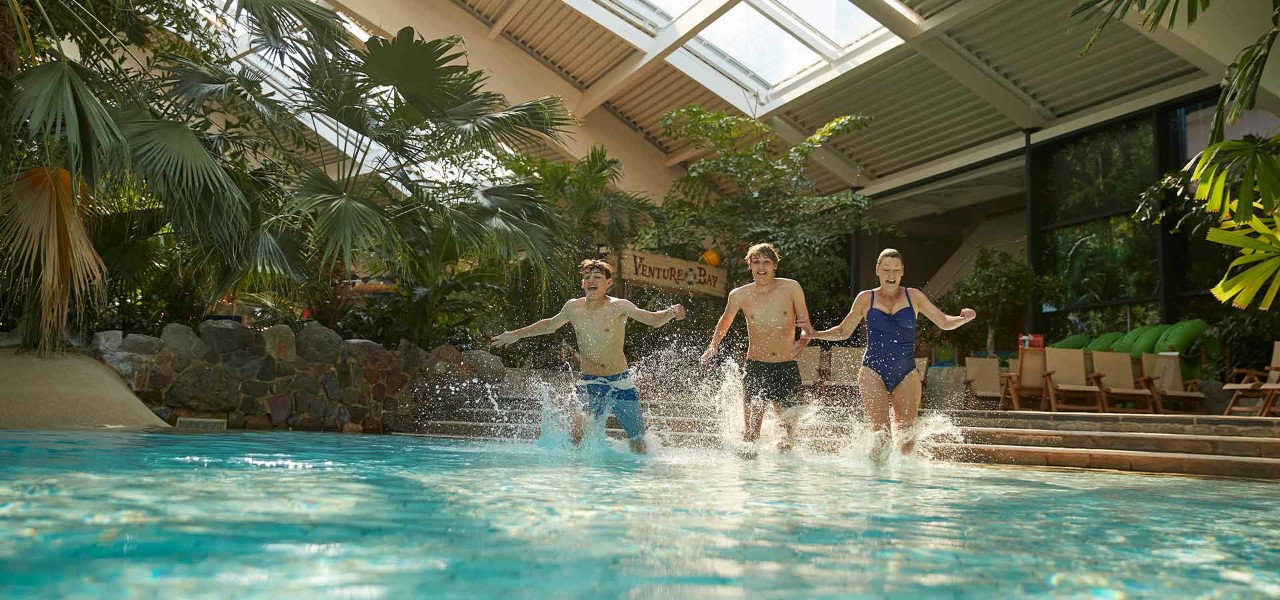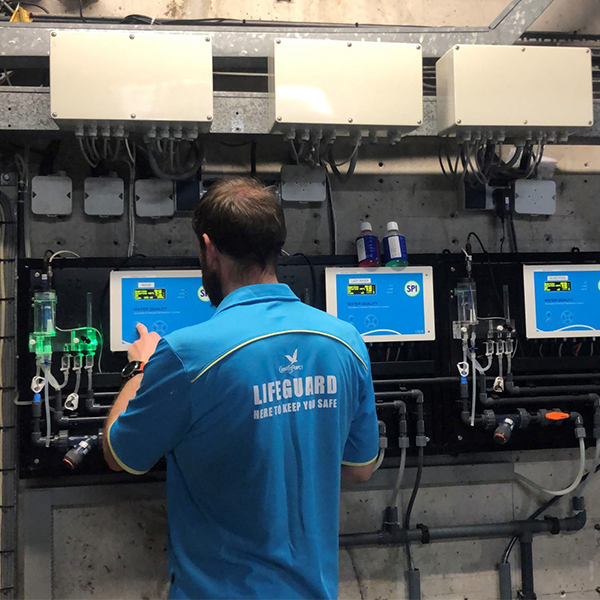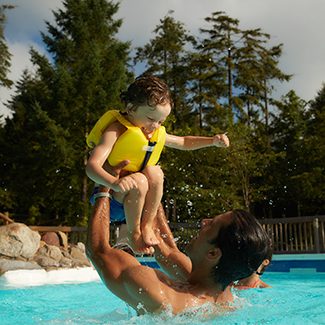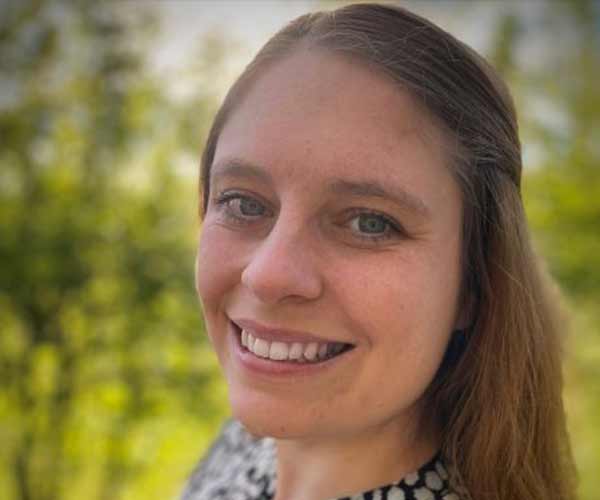The perfect place to picnic and play
Ask anyone what their favourite part of Center Parcs is and we know most people will say the pool, so we’re thrilled that we can reopen our Subtropical Swimming Paradises in the UK from Monday 17th May! Our pools are an amazing place for families to make memories, but there’s a lot of work that goes on behind the scenes to keep everything running smoothly.
We caught up with Longleat Forest’s Barry Taylor, Subtropical Swimming Paradise Manager, and Louise Wakeham, Senior Forest Ranger, to find out how we keep it so clean, where all those plants come from and whether ‘slide tester’ is a real job?
Barry, Louise, thanks for taking the time to talk to us. Firstly, could you tell us a little bit about your role and time at Center Parcs?
Barry: “I started out working in leisure when I was 16 – I was a part-time lifeguard at the local leisure centre. After finishing my degree in Leisure Business Management, I moved up the ranks and managed a number of leisure centres, before joining Center Parcs as the Subtropical Swimming Paradise Manager in 2011.”
Louise: “I’m definitely a Center Parcs newbie! I only joined the business in September 2020, so I’m more used to seeing the village without guests. I’ve worked in horticulture for the last three years and have a passion for exotic plants, so looking after the tropical plants is an absolute dream.”
It must have been a strange introduction to Center Parcs, Louise! Since you joined, we’ve had two closure periods – have they made a big difference to your job?
Louise: “Actually, it probably made my job a little bit easier. Plants need full time care whether there are guests on a break or not – the big difference is that we’re normally working early mornings to try and make sure they’ve been watered and looked after before our guests are up and about. In the Subtropical Swimming Paradise, for example, some of the hoses we use are 150 metres long, so we can’t be dragging that around while people are trying to enjoy their break! While we’ve been closed, we’ve had much more time to devote to the plants.”
So, what did a typical day look like for you whilst the Subtropical Swimming Paradise was closed?
Louise: “There actually weren’t many changes for me! Firstly, we need to keep the plants watered – the pool is a hot, humid environment and the plant beds dry out very quickly. Because of the different light levels within the pool, and the needs of the different plants, we test the soil daily to see what the moisture levels are. This is important because over or under watering plants can be catastrophic for them. We water them all over, making sure we cover the top leaves as well as the roots. It helps keep them clean, but it’s also helping to create humidity – they’re used to being in an environment where people are splashing water around, so they were definitely missing that, and we were trying to recreate it as best we could and mimic the environment they would usually live in. Then there’s pruning, maintenance and generally making sure everything is in the best possible condition to stay healthy. Lastly, we need to keep the plants well-fed – the soil can lack the essential nutrients they would gain from being in the natural environment, so we regularly test it to understand what nutrients are lacking and then top them up – almost like vitamin supplements.”
Barry: “My days were spent with plants of a different sort! Our main work involved checking our plant rooms, which house all the pumps, pipes and filters to keep the pool in working order. We couldn’t just close the doors and walk away – firstly, in the colder months, we could find our pipes freezing if we stopped circulating water, which could cause us real problems, and secondly, Louise wouldn’t be very happy with us if we did!”
Louise: “The plants need the right atmosphere to survive – if we had suddenly turned the temperature right down and got rid of all that humidity, they’d have really suffered, and no one wants to see that happen.”
Barry:“Absolutely not – any change in the conditions has a big impact. In order to keep everything working as it should, we needed to make sure the plant room was safe and functioning – basically, we needed to make sure the water was where it’s meant to be, staying clean and keeping moving. We also needed to check the chemical levels – we have an automated system which uses sensors to detect changes, but we still need to keep an eye on it. We dropped the amount of chemicals we use right down to the bare minimum, but we had to keep a degree of chemical in the water to make sure it couldn’t harbour any bacteria. There’s six plant rooms to check across the Subtropical Swimming Paradise and Aqua Sana and each controls something different – for example, one controls the wave pool, one controls the outdoor pools and rapids and another controls the rides and Venture Cove area. In total, we’re looking after around 1,500,000 litres of water.”
Wow! It sounds like your days are pretty busy. Has there been time for any other lockdown projects?
Barry: “We definitely used the time to get some larger projects finished. We have our rides and flumes serviced four times a year, and that normally takes place overnight, but this year, we’ve been able to have the company in during the day, which is much better for everyone. We’ve also been cracking on with a project to replace the flooring in the pool – that’s been ongoing for a few years, because we have to work in such small sections, but we’re making amazing progress and it should be completed much sooner than planned. They’re all jobs that we would have made happen, albeit with a lot of logistics and some overnight working, but we’ve taken advantage of this time to make sure we get as much done as possible before our guests return.”
Louise: “We’ve finished our major winter pruning and have started a large-scale planting project. I’ve had 660 plants arrive that all needed new homes, including a five-metre tall Ravenala madagascariensis (‘traveller’s tree’) .”
So how many plants are actually in the pool?
Louise: “Right now, there’s between 2,000 and 2,500 and they come from all over the world – we’ve got plants from the Amazon, Asia, Africa and even ones from film sets – if you valued all the tropical plants at Longleat Forest, they’d be worth around £1.1m! Most of our plants are rescued from areas at risk of deforestation, so they come to us for a new chance at life.”
Dare I ask…could you pick a favourite?
Louise: “I really couldn’t! They all have such different qualities. We have some amazing palm trees which still take my breath away when I see them. We’ve got some Spathiphyllum (‘peace lilies’) that are as old as the village is and have grown to around 100cm tall. They’re beautiful but they’re also really tough – they’re great at oxygenating the air and removing harmful chemicals. Then there’s the Hibiscus rosa sinensis, the flower of Malaysia. That makes a delicious tea, full of vitamin C and antioxidants, but it’s also great for treating high blood pressure, anxiety and high cholesterol, as well as improving your metabolism, immune system and digestive system. I love that plants look amazing but have all these medicinal values as well.”
Barry, the pool is normally a hive of activity – it must have been strange seeing it empty. What will a typical day look like for your team once the pool is open again?
Barry: “It was strange and I’m so looking forward to having guests back to enjoy our wonderful pool – we’ve been taking good care of it for them. A normal day for us starts at about 6.30am – there’s several hours of work that needs to be done before we can even think about opening the doors to guests. We have to do a full walkthrough of the building to check fire doors, fire extinguishers and all the usual safety checks. Then we need to check the plant room to make sure all the levels are right before anyone can go near the water. Once that’s all okay, one of the team will swim around the pools to check the grills and light fittings, making sure nothing has come loose overnight. While that’s happening, the rest of the team crack on with cleaning – the whole poolside has to be cleaned and that’s a big task in itself. At the end of the day, we have to do the cleaning again and another walkthrough to close everything down, which means the days finish at around 10.30pm. Oh, and the slides need to be tested every morning as well.”
Well, that sounds like the best job in the world!
Barry: “It’s a pretty good perk of the job, although after a few years the excitement does wear off slightly! We have to make sure everything is working correctly, the lights are all on the right settings and there’s nothing that could hurt someone. So, every morning, two of the team have to ride Tropical Cyclone and Typhoon five times each, and also test the flumes. We also walk the rapids every morning for the same reason.”
You walk through the rapids? How is that possible?
Barry: “Most nights, we actually drain the outdoor pool and the rapids – it stops us from losing the heat overnight. It all goes into huge underground storage tanks, where it’s kept warm and circulating, then in the morning, we let it back in. We walk through the rapids once when they’re empty, then someone goes down them when they’re on to test they’re working properly. The only times we don’t drain the outdoor pool are when it’s really cold outside – that sounds like a juxtaposition, because we do lose heat, but if we drained the pool there’s a risk the surface could freeze and crack, leaving sharp edges that could hurt someone.”
So there really is a lot that goes into getting the pool ready for our guests.
Barry: “Much more than most people realise. We also have to keep on top of our training as well – every lifeguard has to do two hours of training per month to keep their training fresh. With a team of around 85, that’s almost 200 hours of training each month, plus the legal training we have to include in that, and the requirement to renew our National Pool Lifeguard Qualification in full every two years. We’ve got a really important responsibility, so we’ve got to make sure we’re up-to-date with everything.”
And finally, is there any part of your job that would surprise people?
Louise: “I think people are sometimes surprised to learn that the plants are all real – even my friends can’t believe they can grow that big indoors!”





